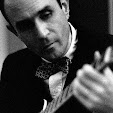Zenith Radio Coporation Showroom, Chicago, Illinois, c.1959
Recently, I visited the Smithsonian American Art Museum in Washington, DC for the the first time. Now I don't know why, but I had rather low expectations for this particular museum - perhaps I just did not know what to expect. And while I was certainly impressed in general, I was nearly awestruck when I rounded a corner only to find myself face-to-face with Harry Bertoia's massive Zenith Radio Corporation Showroom Sculpture.
Harry Bertoia and his creation, c.1959
sculpture detail, photo by author
sculpture detail, photo by author
According to the Smithsonian archives, Bertoia was very specific in what the elements represented in the piece he produced for the late-50s Zenith commission. From left, the largest structure represents the earth, followed by sight, sound, and what he termed electronic control. All were Bertoia's attempt to provide some physical representation of the forces behind the relatively new phenomena of television. Zenith had introduced its first television line in 1948, with color sets following in 1950, so by the end of the decade it was a major player in the ever-growing television market.
sculpture detail, photo by author
The sculpture itself has a sheer presence that photos can barely capture. The slow alternating pulsation of the lights gives the impression of some sort of bio-mechanical organism. Is the wall alive? Is it transmitting a signal from some distant satellite? For a generation immersed in science fiction pulp and soon to embrace Rod Serling's The Twilight Zone, it must have made quite an impression at the time both on the Zenith executives as well as those that were fortunate enough to see the pieces in the original showroom.
As one may expect, the piece spent a significant amount of time neglected in storage. Fortunately, the Smithsonian spent a significant amount of time restoring the work, the story of which is told here.

















4 comments:
Well done - thank you. Great photos, nice angles. A little history: Harry lived in Italy until age 15. In 1957, he was granted a chance to visit Italy for the first time since moving away, some 25 years later. He got so excited and gained so much energy from his journey to his former country that he began to construct huge bursting shapes. This was just one such burst, and later came the dandelions in a more refined sunburst form. Check out the website, harrybertoia.org.
Thank you so very much for the kind words Celia. Obviously I am a big fan of your father's work and am very flattered that you would take the time to read and comment here. I must compliment you on the manner in which you are stewarding Harry's legacy. Your website is excellent and I have linked to it in my piece above. I appreciate the additional background info on your father's 1957 return visit to Italy, as the Italian-American experience is very important to me personally. It is wonderful to hear that it was an exciting energizing moment in his life and I need to look back on some of his work during that era through that lens.
Nice articles and your information valuable and good articles thank for the sharing information mesh chair
Une Ligne Paris has carved out a unique position in the world of fashion jewelry, guided by global jewelry trends and inspired by the intangible beauty that surrounds Une Ligne
Post a Comment